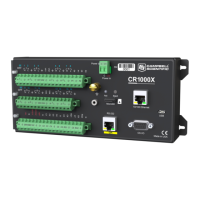l SW12: program-controlled, switched 12 Vdc terminals. It is often used to power devices
such as sensors that require 12 Vdc during measurement. Voltage on a SW12 terminal will
change with datalogger supply voltage. CRBasic instruction SW12() controls the SW12
terminal.
l CS I/O port: used to communicate with and often supply power to Campbell Scientific
peripheral devices.
CAUTION:
Voltage levels at the 12V and switched SW12 terminals, and pin 8 on the CS I/O port, are tied
closely to the voltage levels of the main power supply. Therefore, if the power received at the
POWER IN 12V and G terminals is 16 Vdc, the 12V and SW12 terminals and pin 8 on the CS
I/O port will supply 16 Vdc to a connected peripheral. The connected peripheral or sensor
may be damaged if it is not designed for that voltage level.
l
VX terminals: supply precise output voltage used by analogue sensors to generate high
resolution and accurate signals. In this case, these terminals are regularly used with
resistive-bridge measurements (see Resistance measurements (p. 63) for more information).
Using the SWVX() instruction, VX terminals can also supply a selectable, switched,
regulated 3.3 or 5 Vdc power source to power digital sensors and toggle control lines.
l C terminals: can be set low or high as output terminals. With limited drive capacity, digital
output terminals are normally used to operate external relay-driver circuits. See also Digital
input/output specifications (p. 171).
See also Power output specifications (p. 164).
2.3 Grounds
Proper grounding lends stability and protection to a data acquisition system. Grounding the
datalogger with its peripheral devices and sensors is critical in all applications. Proper grounding
will ensure maximum ESD protection and measurement accuracy. It is the easiest and least
expensive insurance against data loss, and often the most neglected. The following terminals are
provided for connection of sensor and datalogger grounds:
l
Signal Ground ( ) - reference for single-ended analogue inputs, excitation returns,
and a ground for sensor shield wires.
o
11 common terminals
l Power Ground (G) - return for 3.3 V, 5 V, 12 V, and digital sensors. Use of G grounds for
these outputs minimizes potentially large current flow through the analogue-
voltage-measurement section of the wiring panel, which can cause single-ended
voltage
2. Wiring panel and terminal functions 10

